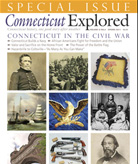(c) Connecticut Explored Inc. Spring 2011
Subscribe/Buy the Issue!
One might not immediately think of Connecticut when considering the American Civil War. We were, after all, a relatively small state, both geographically and in terms of population, when compared to other Northern states. There were no battles fought here, and though some might assume otherwise, Connecticut was no bastion of abolitionist thought. Regardless of such truths, Connecticut has a rather remarkable Civil War history; indeed, one that easily matches and in some cases surpasses that of other states.
In war industry alone, Connecticut was home to such manufacturers as Colt, Sharps, and many others, all instrumental to the very survival of the Union war machine. The army was filled with Connecticut men. Some 47 percent of our male population, 55,000 men, between the ages of 15 and 50 marched South to fight. They were involved in every major engagement of the war, from Bull Run to Antietam and Gettysburg, the siege at Petersburg, the march through South Carolina, and the acceptance of Confederate General Robert E. Lee’s surrender at Appomattox Court House. The state’s 29th Colored Regiment Infantry numbered among the first troops to enter the fallen Confederate capital, Richmond.
Connecticut also suffered such ignominious, yet ultimately patriotic, fates as having the first officer, Colonel Elmer Ellsworth, the first Union general, Nathaniel Lyon, and the first naval officer, Captain James H. Ward, killed in action. We were home to the first Soldiers’ Aid Society, created in Bridgeport, and the first veterans’ home, Fitch’s Soldiers’ Home, in Darien. Connecticut also boasts one of the oldest Civil War monuments in the North, located at the Congregational Church in Kensington.
There are also more troubling stories. Famed abolitionist William Lloyd Garrison once labeled Connecticut as the “Georgia of New England,” decrying the state’s harsh, racist treatment of Prudence Crandall’s school for African-American girls in the 1830s. Although Crandall is today the Connecticut state heroine, we must remember that she was heroic in the face of her neighbors, who vandalized the school house and poisoned its well with manure. Most in the state had little patience for abolitionists, and the majority of Connecticut men certainly did not march South in defense of black rights. This was a fight for Union.
Nor did that fight occur solely on Southern battlefields. The war was hotly contested in Connecticut, where the Republican and Democratic parties battled for political supremacy, mobs faced off in the streets, and the very fate of the state and its commitment to the Union hung in the balance. Connecticut was by no means universally in favor of fighting the war. There is in all of this history both a grand and troubling past that continues to echo into the 21st century.
Many of these subjects are addressed in this special issue of Connecticut Explored. We have attempted to offer a range of subjects and perspectives, ones that provide a window into a difficult history that affected many generations. The issue is part of the wider 150th anniversary commemoration of Connecticut and the Civil War, spearheaded by Central Connecticut State University, the Connecticut State University System, our many partners that make up the Connecticut Civil War Commemoration Committee, and the Connecticut Civil War Commemoration Commission, with funding from Travelers Foundation and the Connecticut Humanities Council.
To commemorate Connecticut’s involvement in the war, state and local organizations have developed a broad series of events that will stretch over a four-year period, from April 2011 to April 2015. The kick-off event will occur on April 15, 16, and 17, with a full-day conference followed by a weekend of activities that include a Civil War encampment, battle reenactments, period music, a vintage baseball game, living history events, and talks on a wide variety of subjects. A master calendar is available at www.ccsu.edu/civilwar.
Please join us in learning about a time when America, including Connecticut, was torn over the nation’s future and the sacrifices that it took to mend the wounds. Finally, I would like to take this opportunity to thank the many authors who contributed to this special issue, and especially editor Jennifer Huget and publisher Elizabeth Normen and the Connecticut Explored editorial team, who devoted themselves to this and every excellent issue of Connecticut Explored.
Dr. Matthew Warshauer is chair of Connecticut Explored’s editorial board and served as guest editor of this issue.
Explore!
Read all of our stories in the Spring 2011 issue
Read all of our stories about Connecticut at War, including our special Emancipation Proclamation issue (Winter 2012/2013)

